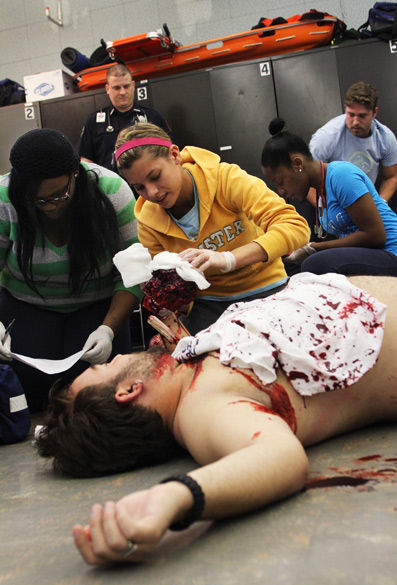Trained hands are key in chain of survival

December 8, 2013
Allana Cronk, center, a sophomore from Plainfield studying physical therapy, and Kathryne Meyers, left, a senior from Sauk Village studying health education, administer Emergency Medical Responder treatment Thursday on demonstration victim David Peace, a senior from West Chicago studying therapeutic recreation, during the Health Education 434 advanced first aid final exam.
Peggy Wilken, assistant clinical professor, said the exam is a realistic emergency scenario and is often the first time students see the blood and moulage, or mock injuries.
“If they’re going to make mistakes, I want them to make them in here with me,” Wilken said. “I can correct it here and nobody dies.”
Advertisement
Wilken said the shock and pressure simulated in the classroom prepares the students for real-life situations and helps curb a common mistake many young responders make, getting tunnel vision and focusing only on the blood.
One measure Wilken takes to ensure a realistic environment is having paramedics in the classroom during the exam.
The exam has been observed by Jackson County Ambulance Service Emergency Medical Technicians for 15 years, and the EMT presence is a key educational tool, Wilken said. The paramedics observe the actions of each team of responders and evaluate the proper completion of the team’s assessment.
After the students believe they have completed the assessment, they must brief the paramedic as they would in real life. Wilken said the paramedics not only provide useful and kind evaluations, but also help to familiarize the students with the Emergency Medical Services system.
Nathaniel Dill, an EMT for Jackson County Ambulance Service, said the evaluations can provide students with genuine and helpful information about their performance from paramedics that have experience in the field.
“It’s easy to get tunnel vision in the field, so getting pointers on how to improve their performance is important,” Dill said.
Having emergency medical responders on the scene helps save paramedics time and keeps everything flowing smoothly, Dill said.
Advertisement*
He said having help with minor first aid also allows paramedics to get to the major injuries faster.
Wilken said the exam observed by the paramedics is not intended to embarrass the students, but to educate and train them.
“The mistakes they make here, they won’t make again because they just had a paramedic looking over their shoulders and they have me standing there as well,” Wilken said.
On Nov. 17 when Brookport was hit by a tornado, hundreds of emergency responders from southern Illinois and western Kentucky arrived on the scene to help.
Wilken said when a natural disaster hits, it is important for students to understand that it can overrun the EMS system and that they are commonly the first hands on deck before a paramedic or ambulance can arrive.
“Emergency responders are key people. It’s part of the chain of survival,” Wilken said. “Once they’re there and they’re medically trained, they can make a life or death decision for a person.”
Emergency responders are often thrust into the middle of an accident or disaster and Wilken said her students will be able to walk out of the classroom and help save lives.
The main reason Wilken puts her students under pressure during the exam is because that is what it is going to feel like when they’re out there, she said.
“The more hands on deck, the better the chances of survival,” Wilken said. “Especially if the hands are trained.”
Advertisement








